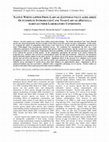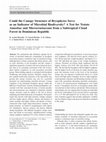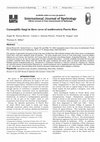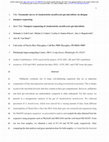Papers by Carlos Jose Santos Flores

Invasive species are a major focus within conservation biology. The widely introduced Cane Toad, ... more Invasive species are a major focus within conservation biology. The widely introduced Cane Toad, Rhinella marina, has attracted particular interest in studies of the effects of invasive species on native communities. In this study, we examined the effects of competition with invasive Cane Toad larvae on the growth, development, and survival of native White-lipped Frog (Leptodactylus albilabris) larvae. We conducted two experiments; the first was a food calibration experiment to determine appropriate high and low food concentrations, and the second was a competition experiment in which we varied species compositions and food availability. In the food calibration experiment, lower food levels reduced the survival of both species. In the competition experiment, the presence of R. marina reduced the proportion of L. albilabris that survived to metamorphosis under the high food treatment. Otherwise, the introduced species had little negative impact on the native species. In contrast, larvae of R. marina experienced severe reductions in growth and survival in the presence of L. albilabris. Significant effects of the presence of L. albilabris on R. marina development were observed as early as the first two weeks, and continued up to metamorphosis. We conclude that L. albilabris larvae outcompete R. marina larvae when their numbers are approximately equal. Adaptations to life in ephemeral habitats may have provided L. albilabris with a competitive advantage over R. marina. Further studies are needed to determine if these patterns persist under natural conditions.

The Journal of Agriculture of the University of Puerto Rico, 1969
Six reservoirs of Puerto Rico were monitored over a 32-month period to establish relationships be... more Six reservoirs of Puerto Rico were monitored over a 32-month period to establish relationships between their nutrient concentration status and different thresholds of ecological impairment. The selected reservoirs embody the productivity spectrum of reservoirs on the island. Median concentrations of total phosphorus (TP) for epilimnion waters (1 m) were as follows: Cerrillos, 10 µg/L; Cidra, 33 µg/L; Guajataca, 10 µg/L; La Plata, 49 µg/L; Patillas, 6 µg/L; and Toa Vaca, 22 µg/L. Likewise, median concentrations of total nitrogen (TN) were:Cerrillos, 0.22 mg/L; Cidra, 0.74 mg/L; Guajataca, 0.28 mg/L; La Plata, 0.55 mg/L; Patillas, 0.23 mg/L; and Toa Vaca, 0.34 mg/L. Strong positive correlations were observed between nutrients and chlorophyll a (Chl-a). Correlation coefficients were 0.74 for the relationship between TP and Chl-a, and 0.66 for TN vs. Chl-a. Increases in algal biomass (as measured by Chl-a) diminished the depth of light penetration into the water column (i.e., Seechi dep...
SIL Proceedings, 1922-2010, 2010

Microbial Ecology, 2012
The mechanisms that ultimately regulate the diversity of microbial eukaryotic communities in bryo... more The mechanisms that ultimately regulate the diversity of microbial eukaryotic communities in bryophyte ecosystems remain a contentious topic in microbial ecology. Although there is robust consensus that abiotic factors, such as water chemistry of the bryophyte and pH, explain a significant proportion of protist and microcrustacean diversity, there is no systematic assessment of the role of bryophyte habitat complexity on such prominent microbial groups. Water-holding capacity is correlated with bryophyte morphology and canopy structure. Similarly, canopy structure explains biodiversity dynamics of the macrobiota suggesting that canopy structure may also be a potential parameter for understanding microbial diversity. Canopy roughness of the dominant bryophyte species within the Bahoruco Cloud Forest, Cachote, Dominican Republic, concomitant with their associated diversity of testate amoebae and microcrustaceans was estimated to determine whether canopy structure could be added to the list of factors explaining microbial biodiversity in bryophytes. We hypothesized that smooth (with high moisture content) canopies will have higher species richness, density, and biomass of testate amoebae and higher richness and density of microcrustaceans than rough (desiccation-prone) canopies. For testate amoebae, we found 83 morphospecies with relative low abundances. Species richness and density differed among bryophytes with different bryophyte canopy structures and based on non-metric multidimensional scaling, canopy roughness explained 25% of the variation in species composition although not as predicted. Acroporium pungens (low roughness, LR) had the lowest species richness (2± 0.61 SD per gram dry weight bryophyte), and density (2.1± 0.61 SD individual per gram of dry weight bryophyte); whereas Thuidium urceolatum (high roughness) had the highest richness (24±10.82 SD) and density (94± 64.30 SD). The fact that the bryophyte with the highest roughness had the highest levels of diversity for testate amoebae suggests that moisture levels at the level of the bryophyte canopy may not represent a biodiversity driver in a cloud forest with high relative humidity; however, high roughness could generate a dynamic and fluctuating moisture environment with concomitant alternating microbial communities. A total of 26 microcrustacean morphospecies were found across 11 bryophytes; however, no bryophyte canopy effect was detected on their richness and density. Microcrustacean mean density was low ranging from less than one individual per 50 cm 2 of bryophyte in Leucobryum (LR) to a maximum of 6±3.37 SD individuals/50 cm 2 in Monoclea (LR). This lack of pattern suggests that possible explanatory variables may be related to larger scale processes than those examined in this study.
Hydrobiologia, 2003
Page 1. Hydrobiologia 500: 145155, 2003. K. Martens (ed.), Aquatic Biodiversity. © 2003 Kluwer A... more Page 1. Hydrobiologia 500: 145155, 2003. K. Martens (ed.), Aquatic Biodiversity. © 2003 Kluwer Academic Publishers. Printed in the Netherlands. 145 Dumontia oregonensis n. fam., n. gen., n. sp., a cladoceran representing ...
Hydrobiologia, 2001
Page 1. Hydrobiologia 445: 3750, 2001. © 2001 Kluwer Academic Publishers. Printed in the Netherl... more Page 1. Hydrobiologia 445: 3750, 2001. © 2001 Kluwer Academic Publishers. Printed in the Netherlands. 37 Physical-chemical influences on vernal zooplankton community structure in small lakes and wetlands of Wisconsin, USA ...

International Journal of Speleology, 2009
Fifty species of guanophilic (bat guano-loving) fungi were isolated from field-collected samples ... more Fifty species of guanophilic (bat guano-loving) fungi were isolated from field-collected samples within three caves in southwestern Puerto Rico; most were mitosporic fungi (23 species). The caves studied were Cueva La Tuna (Cabo Rojo), Cueva de Malano (Sistema de Los Chorros, San Germán), and Cueva Viento (El Convento Cave-Spring System, Guayanilla-Peñuelas). The most conspicuous fungus by far was the zygomycete Circinella umbellata (Mucorales). Circinella umbellata dominated the bat guano incubation chambers (Petri dishes lined with sterile filter paper moistened with sterile water) at ambient laboratory conditions. Nineteen species of basidiomycetes (e.g., Ganoderma cf. resinaceum, Geastrum cf. minimum, Lepiota sp., Polyporus sp., Ramaria sp.) and three species of ascomycetes (Hypoxylon sp., Xylaria anisopleura, and X. kegeliana) were also recorded. They were found on soil, rotting leaves, bark and rotting wood, buried in bat guano located below natural skylights or sinkholes.
The Journal of Agriculture of the University of Puerto Rico
Aquatic fungi were isolated from sea foam, leaf litter, beach sand, and driftwood in an estuary k... more Aquatic fungi were isolated from sea foam, leaf litter, beach sand, and driftwood in an estuary known as "La Boca" (river mouth) of the Manatí River in Barceloneta, northern Puerto Rico. Observations of the baits (sterilized balsa wood) and incubated organic debris, revealed the presence of 28 species of aquatic fungi, 13 of which belong to the ascomycetes and 15 to the mitosporic fungi. The species Arenariomyces triseptatus, Corollospora cf. colossa, C. filiformis, Halosphaeria sp., Kirschsteiniothelia sp., Astrosphaeriella aff. mangrovei, Torpedospora radiata (Ascomycota), Brachiosphaera tropicalis, Campylospora sp., and Clavatospora bulbosa (Mitosporic fungi) were the most common in the samples. Eleven species are new records for Puerto Rico; six fungal isolates could not be identified.
Seven species of myxomycetes are reported as new records for the Mona Island Commonwealth Reserve... more Seven species of myxomycetes are reported as new records for the Mona Island Commonwealth Reserve, Puerto Rico. They are Ceratiomyxa fruticulosa, Cribaria intricata, Dictydium cancellatum, Fuligo septica, Lycogala sp., Stemonitis axifera and Tubifera ferruginosa.
SIL Proceedings, 1922-2010
were calculated from sampling depths and bathymetric data. Water density was calculated from the ... more were calculated from sampling depths and bathymetric data. Water density was calculated from the equations of CHEN & MILLERO (1986). Lake stability was determined following TOWNSEND (1999) and WETZEL & LIKENS (2000).

Internationale Vereinigung für theoretische und angewandte Limnologie: Verhandlungen, 2009
Tropical reservoirs frequently suffer from high rates of sediment and nutrient loads (SALAS & MAR... more Tropical reservoirs frequently suffer from high rates of sediment and nutrient loads (SALAS & MARTINO 200 l, WETZEL 200 l). Alloctonous nutrient inputs through runoff largely control the entrance o f nutrients and other dissolved and particulate materials; however, interna! cycling during mixis is a mechanism for the vertical transfer and exchange of nutrient through the water column. Seasonal changes in precipitation and thermal regimes are important driving factors for water column stratification and mixing pattems in the tropics (HORNE & ÜOLDMAN 1994). The excessive input of nutrients influences the structure and dynamics ofthe phytoplankton community by increasing primary production and altering species composition (CHALAR 2006). Hence, assessing the phytoplankton assemblage of a reservoir can be used as an indicator of its trophic state and overall ecological integrity (REYNOLDS 1986). There is limited information of phytoplankton diversity and temporal dynamics in tropical zon...
Caldasia, 1997
Se han informado pocas especies de los Agaricales (Basidiomycota) de los paramos colombianos. Guz... more Se han informado pocas especies de los Agaricales (Basidiomycota) de los paramos colombianos. Guzman y Yarda (1978), Pulido (1983), Saldarriaga et al. (1988) y Guzman et al. (1994) entre otros, ofrecen valiosa informacion sobre la taxonomia y distribucion de estos.
Caribbean Journal of Science, 2021
Biota Colombiana, 2017
The diversity of Ingoldian hyphomycetes in Colombia is known from three studies that reported in ... more The diversity of Ingoldian hyphomycetes in Colombia is known from three studies that reported in total 18 species of these fungi. For eastern Colombian there are no records of these microorganisms. In this study foam samples were collected in the Frio River drainage in the municipality of Floridablanca (Santander) in October 2013 and September 2014. In this inventory 23 hyphomycetes taxa are reported of which 20 are new records for Colombia. Clavatospora tentacula was found in both sample periods. A marked decline in species richness related to the reduction of rainfall in the year 2014 was observed.
Verh. Internat. …, 2008
were calculated from sampling depths and bathymetric data. Water density was calculated from the ... more were calculated from sampling depths and bathymetric data. Water density was calculated from the equations of CHEN & MILLERO (1986). Lake stability was determined following TOWNSEND (1999) and WETZEL & LIKENS (2000).

Millipedes constitute one of many soil-inhabiting organisms that act as important components of l... more Millipedes constitute one of many soil-inhabiting organisms that act as important components of litter decomposition and nutrient recycling in terrestrial ecosystems. This is thanks in part to the microbial diversity that they contain in their gut compartments. However, millipedes and their gut microbiota are understudied, compared to other arthropods. For this reason, we partook in a metagenomic analysis of the gut of Anadenobolus monilicornis. We collected specimens of A. monilicornis, which were starved for a varying amount of time, from different municipalities of Puerto Rico. Once the DNA from their guts was extracted and sequenced using the MinION nanopore sequencer, we proceeded to analyze and compile the data obtained from the sequencer using programs such as Phylosift and MEGAN6 and the web-based MG-RAST. From our two best samples, we obtained a total of 87,110 and 99,749 reads, respectively. After comparing the data analyses and gene annotation done for both samples, we found that the bacterial .
The Journal of Agriculture of the University of Puerto Rico
Seven species of myxomycetes are reported as new records for the Mona Island Commonwealth Reserve... more Seven species of myxomycetes are reported as new records for the Mona Island Commonwealth Reserve, Puerto Rico. They are Ceratiomyxa, fruticulosa, Cribaria intricata, Dictydium cancellatum, Fuligo septica, Lycogala sp., Stemonitis axifera and Tubifera ferruginosa.
Aquatic fungi were isolated from sea foam, leaf litter, beach sand, and driftwood in an estuary k... more Aquatic fungi were isolated from sea foam, leaf litter, beach sand, and driftwood in an estuary known as "La Boca" (river mouth) of the Manatí River in Barceloneta, northern Puerto Rico. Observations of the baits (sterilized balsa wood) and incubated organic debris, revealed the presence of 28 species of aquatic fungi, 13 of which belong to the ascomycetes and 15 to the mitosporic fungi. The species Arenariomyces triseptatus, Corollospora cf. colossa, C. filiformis, Halosphaeria sp., Kirschsteiniothelia sp., Astro-sphaeriella aff. mangrovei, Torpedospora radiata (Ascomycota), Brachio-sphaera tropicalis, Campylospora sp., and Clavatospora bulbosa (Mitosporic fungi) were the most common in the samples. Eleven species are new records for Puerto Rico; six fungal isolates could not be identified.

Uploads
Papers by Carlos Jose Santos Flores